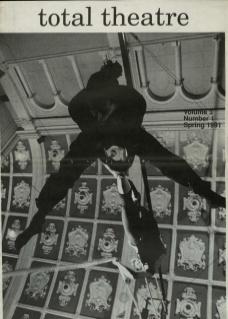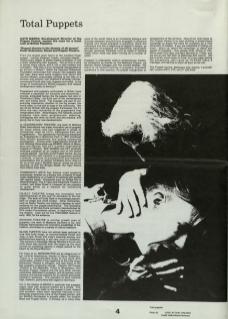From the largest giant figure to the smallest finger puppet – moving shadows, masks, animated objects – almost every aspect of plastic theatre embodies, or has a direct relationship with, puppetry. The artform is alive in almost every culture, and is rich in both tradition and innovation. Why then is it so constantly downgraded as an art form in Britain? When the Calouste Gulbenkian Foundation announced their enquiry into puppetry late last year, there were some sniggers from senior Arts Council officers, presumably amused at the idea of a serious arts enquiry into children's birthday parties, commercial Punch and Judy, fluppets and turtles. Is the range of contemporary British puppetry and related developments really so derisory?
Puppeteers and puppetry enthusiasts in Britain have inherited a reputation for insularity and eccentricity – strange, antiquated beings like the people next door in Rosemary's Baby, not quite part of the contemporary arts and media world. Yet puppets are part of our everyday experience, whether on the big screen, the home video, or live and at large in the community. We are all too familiar with the puppets themselves, but it's often the very invisibility of the puppeteers that marginalises them. Nevertheless, the networks around puppetry have been progressively widening, overlapping with other art forms and arts practice, and giving rise to many new developments.
In celebratory theatre, the work of Welfare State International has made innovative use of puppets for many years, and has triggered a range of companies, such as I.O.U., Emergency Exit, and Puppetworks. The spectacular Ramayana presented by Puppetworks in Battersea Park in 1987 combined both artistic excellence and quality community participation. Among other organisations striving for and attaining these goals are WOMAD (World of Music, Arts and Dance), and LIFT (London International Festival of Theatre). Both WOMAD and LIFT positively embrace puppetry as an integral part of the global cultural agenda. Currently at the Puppet Centre, we are exploring links with carnival in a programme entitled Lionhunt, a series of processional and dramatic presentations with an African Caribbean focus: look out for us at this year's WOMAD festival, where we will be teaming up with the Bhagia Natak, the Tiger Dance from Orissa, East India.
Community arts has always used puppetry extensively, whether as a literacy tool, a feature of large scale celebrations, or a medium for working with people with special needs. Companies such as Jubilee Arts in West Bromwich, The A Team, and Parachute Theatre in London, and Hope Street in Liverpool all use puppetry to great effect as a medium for community development.
Object Theatre brings the innovation and experimentation of film and TV animation to the live stage. The work of Faulty Optic is increasingly popular, both on stage and the small screen. Other companies, such as Siesta Theatre, are helping to develop an adult audience for live puppet performance. The increasing popularity of 3D stop-frame animation (demonstrated by C4's recent Fourmations series), is beginning to feed live theatre. Look out for the VisionMix festival in early 1992, for the evidence.
Shadow theatre is another growth area of puppetry: the work of Madame Souhami & Co. and Kabutar demonstrates the innovatory possibilities of the medium, and draws on a variety of cultural traditions. Glove puppets have not entirely been reduced to cute little fluffy things, or commercialised Punch and Judy: in fact, Punch and Judy's essential anarchy and establishment-bashing is still very much in evidence. This summer in Swanage, Wendy Wharam's Punch and Judy show was evicted from the beach by the local council for protesting against a staged assault on the beach by the Royal Marines! For many of us, marionettes are an integral part of our cultural experience, thanks to Gerry Anderson. There is a considerable body of live work with marionettes, notably in the repertoire of the Little Angel Marionette Theatre in Islington, and also those of the few puppetry producing venues. Cannon Hill Puppet Theatre in the Midlands, Polka in Wimbledon, and Norwich Puppet Theatre are the only other venues exclusively dedicated to puppetry, and all operate under extreme commercial pressure for an almost exclusively children's audience. The standard of work remains high, however, particularly with regard to technique. It is in the theatre of masks in particular that puppetry aligns itself with physical theatre as a whole. The relationship of the mask to the puppet is both integral and complex: mask work regularly features in our workshop programmes here at the Puppet Centre, and our Scottish counterpart is actually called The Scottish Mask and Puppet Centre. In Europe, as in many other parts of the world, there is an increasing dialogue and overlap between practitioners engaged in physical theatre and those engaged in puppetry: there are indications that this is beginning to happen in Britain, as perceptions of puppetry are expanding, particularly through workshop initiatives such as those of Welfare State, which have now been running for a number of years.
Puppetry is extensively used in contemporary theatre, by companies as diverse as The Medieval Players, Lip Service, Bolton Octagon, and The London Bubble. Yet there is no formal training in puppetry available anywhere in this country, no proper recognition or development of the artform. One of our main tasks at the Puppet Centre is to start building a broad-based campaign to argue the case for puppetry as a vital dimension of theatre. If you are interested in finding out more about us, about the campaign, or about any aspect of puppetry, then please write, phone or visit. We're open from 2pm until 6pm Monday to Friday, and we live on the first floor of Battersea Arts Centre. We are a small, manic team of three, so if you keep getting the answerphone, don't give up. Please leave a message, and we'll be in touch as soon as we can.

